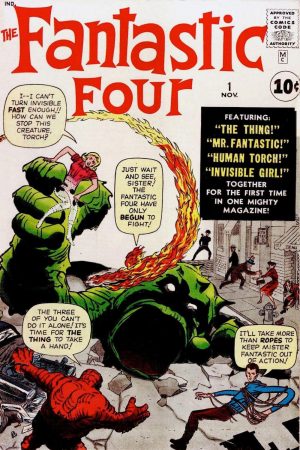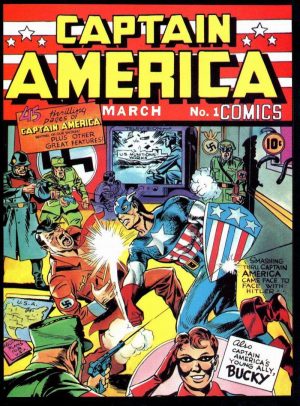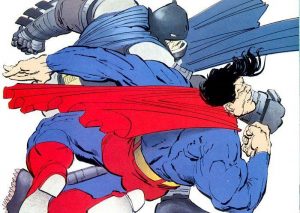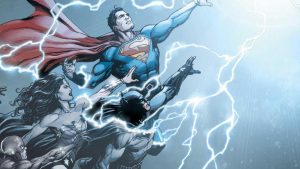A history of heroes
Amelie Lee, Asst. Feature Editor
November 8, 2017
1938
To start the Golden Age of comic books, DC Comics released “Superman.” Superman’s amazing powers grabbed reader’s attention and marked the start of the rise of superheroes in pop culture.
1941
Marvel Comics, which was then known as timely publications, published “Captain America,” who was a Nazi-fighting symbol of hope in the face of World War II.
1961
Along with Jack Kirby, Stan Lee created the first fantastic four comic. He went on to create a number of iconic heroes for marvel, including Spiderman, The Hulk, Iron Man and the X-Men.
1986
the release of “Batman: The Dark Knight Returns” embodies the more serious nature and dark content featured in books classified in the modern age of comic books.
2016
DC Comics relaunched with "DC Universe Rebirth," bringing back beloved characters, new stories and twists and the incoming confrontation between the Justice League and the legendary Watchmen.





It’s a bird! It’s a plane! It’s (almost) a century of the superhero archetype in popular media! Since their first mainstream appearance in the early 1900s, superheroes, especially in the past decade, have taken over television shows, comics, movies and our lives.
From fanatic kids to nostalgic adults, people of all ages obsess over classic heroes such as Superman, Spiderman, Batman and Wonder Woman. Despite concerns that superhero movies are full of overused tropes and that saving the world is overdone, superheroes and their alternate personas have sustained their place in the media and entertainment for decades.
Superheroes began flying up in prevalence during the Golden Age of Comic Books, spurred by the creation of “Superman” by DC Comics in 1938. Complete with stunning super powers, a secret identity, a vicious archenemy and a beautiful love interest, Superman embodied what a true hero looked like in the 1930s, and his comics quickly grew in popularity. Seeing the public’s positive reaction to the patriotic hero from the planet Krypton, DC Comics swiftly released “Batman,” “The Flash” and “Wonder Woman.”
The rise in popularity of the caped avenger came along with weekly serial films based on popular comics, intended for children, starring various superheroes. However, as serial films decreased in popularity, so did superheroes in the film industry.
In the 1940s, Marvel Comics, then called Timely Publications, released the “Human Torch,” and they were greeted with success. While the Human Torch was well received, he did not leave as much of an impression on his readers, but created an active fanbase for Marvel’s next release: “Captain America.” A Nazi-fighting symbol of freedom, Captain America was an instant hit.
These heroes symbolized a beacon of light in a time when life seemed bleak. In the midst of World War II, everyday citizens looked toward Wonder Woman jumping at every opportunity to fight injustice and comic covers portraying Captain America punching Adolf Hitler in the face. Superhero comics not only entertained the media, but also provided a figures of hope who could save the world in any situation.
During the 1950s, heroes returned to the big screen through hit television shows, including George Reeve’s “The Adventures of Superman” live action TV series that lasted for six years, and Adam West’s “Batman” from 1966 to 1968. Following suit, the first Batman film was created in 1966, based on the television show. These new releases created a shift in the media’s interest in heroes―with the public looking forward to new movies and TV shows, rather than the newest edition of their favorite comic strip.
This was not to say comics were obsolete, with the release of the “Fantastic Four” and the “Justice League” comic strips during this decade, heroes worked together for the first time. The new development established the interconnected DC universe and brought a new group of Marvel heroes that abandoned their humble Clark Kent secret personas in favor of a rich and famous Tony Stark lifestyle in the public eye.
As time passed, the Golden Age of Comics ended, and the popularity of classic heroes began to decline. Heroes evolved, but continued to reflect the political atmosphere of the time period: during the 1970s, the rise of anti-heroes began to show up in popular culture and were focused on the harsh realities of life. Heroes like Marvel’s Wolverine and Iron Man continued fighting crime despite their questionable character and lack of a strong moral backbone.
As blockbusters swept the film industry in the late 1970’s, Marvel and DC Comics began to release movies featuring classic heroes from the original comics from the Golden Age. DC Comics’ 1978 Superman film skyrocketed superheroes into popular culture once again, winning the first Oscar (for visual effects) given to a superhero film. TV still played an important role in the superhero culture, with the CBS series “Wonder Woman” marking the first superhero show starring a woman on television. Over the next ten years, multiple sequels to the public’s favorite DC heroes were published, mainly Batman and Superman.
The 90s saw the first “Captain America” movie released by Marvel. Deemed a failure by most critics, the movie prevented Marvel from releasing another major film until the start of the 21st Century.
Despite the flop, the entertainment industry’s thirst for superhero movies refused to be quenched. The early 2000s brought waves of movies from both DC Comics and Marvel, featuring favorites from original comics such as “X-Men” and “The Incredible Hulk.”
DC Comics continues to release remakes of “Superman” and “Batman,” and the first two movies from Christopher Nolan’s “Dark Knight” trilogy were greeted with almost unanimous adoration for their dark and thrilling content. Recently, 2017’s “Wonder Woman” has also garnered mass attention, as the first full-length film starring a female superhero. The character has become a feminist icon, through the impeccable portrayal by Gal Gadot.
Fanbases for heroes have been growing through the internet and by the time “The Avengers” was released in 2012, people were obsessed with heroes. Recent movies and TV shows showed heroes and antiheroes working together in unstoppable teams, with DC’s “Suicide Squad” and “Legends of Tomorrow,” along with Marvel’s “Defenders” and “Agents of Shield” gaining in popularity over recent years.
The “Avengers” dream team gave fans an opportunity to see all their favorite heroes on screen at the same time, further spurring fervor for Marvel content. In recent years, the Marvel universe has expanded, pulling together heroes from every corner―from “Doctor Strange” to the “Guardians of the Galaxy”―ready to fight in “Infinity Wars”.”
While superheroes no longer serve as hope for a country faced with war, society still seems to look to the heroes on our screens as symbols of justice. Their faces and identities are ingrained into pop culture, and celebrities are universally known for the hero they portray.
With new heroes released through television shows and movies like “Arrow,” “Ant Man” and “The Flash,” it’s clear that the entertainment world adores someone who does not hesitate to fly to the rescue. While other pop trends come and go, we will always need our heroes―like Gotham needs Batman.








